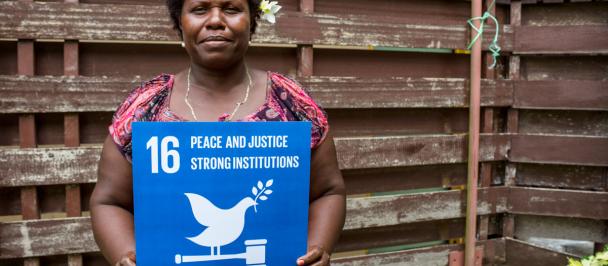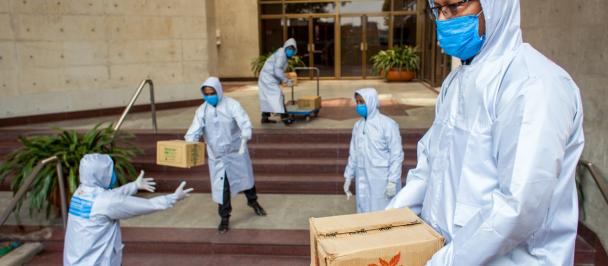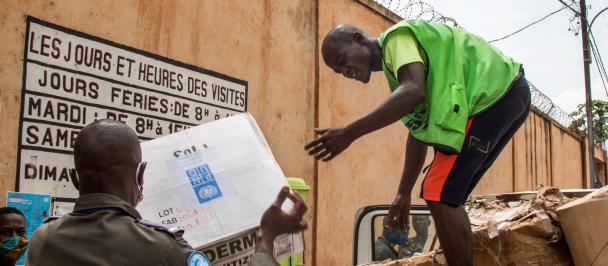A year ago, when we marked International Migrants Day, the world seemed in perpetual motion: in 2019, 270 million people migrated internationally and 750 million moved within their own countries.
However, within a few short months, COVID-19 had radically impacted human mobility as we know it. With lockdowns, travel restrictions and increased remote working, human travel – including migration – has reduced significantly. Just looking at OECD countries, migration flows plummeted by 46 percent in the first half of 2020 and 72 percent in the second quarter, reaching historic lows (IOM).
Migrant workers are performing crucial roles as essential workers during the COVID-19 pandemic
Despite the slowdown in human movement, the pandemic has had one unexpected impact on migrants – their important contributions in responding to the global health emergency have come into the spotlight.
Amid the tragedies of lives lost or pushed into poverty, our spirits have been lifted by symbols of solidarity, such as the collective gratitude we have shown to the tireless commitment and life-saving efforts of health workers around the world.
Some of the worst-hit countries including the United States, France, Spain, Italy, Germany, Chile and Belgium depend on migrants for healthcare. In the UK, a third of doctors and a fifth of nurses are foreign-born while in Chile one in five doctors are foreign-trained (OECD).
Other hard-hit countries also depend on migrants in their service, sales, agriculture, forestry and fisheries sectors. In the European Union, 13 percent of key workers were foreign born in 2019 (European Commission).
Migrants are also among the most vulnerable to the impacts of COVID-19
While this serves as an important reminder of the contributions that migrants make to society, we have also seen that migrant communities are among the hardest hit by the pandemic.
For one, they are much more vulnerable to health risks. Low-skilled labour migrants living in crowded dormitories have been disproportionately affected: by June, over 95 percent of the confirmed cases in Singapore were migrants.
A new study, part of a partnership by UNDP and the Pardee Center for International Futures at the University of Denver, estimates that over one billion people could be pushed into extreme poverty by 2030 – up to a quarter of them because of the pandemic’s devastating legacy.
Migrant workers are particularly vulnerable to job losses, and many are already living in poverty. Looking just at migrant domestic workers alone, nearly 55 million of them risk losing their jobs, housing and incomes – and thus their ability to access healthcare for themselves and their families (ILO).
This is compounded by the fact that many domestic workers are employed informally. With no access to local social services and being unable to return home due to travel restrictions, they risk being trapped in a foreign country without housing or income.
Harnessing digital tools for safer migration
While the world faces dramatic challenges, it also has improved tools to help migrants move safely. UNDP is harnessing digital innovation to support people on the move by accelerating economic inclusion and recovery, boosting growth and opening up opportunities.
In Nepal about 300,000 migrant workers are expected to return home due to the pandemic. To help the country to manage this high volume of returns, UNDP's Accelerator Lab is partnering with local incubator CellApp Innovations to support local authorities to live track COVID-19 cases while also reporting quarantine data and disseminating health updates to the public.
Since the beginning of the crisis, UNDP has been working hard with the UN family and other partners on social protection, including cash transfers, universal health coverage and access to other basic services. These will be central to uprooting the inequalities that permeated societies before COVID-19, and that are starkly visible today.
With the UN refugee agency (UNHCR), UNDP is linking up the health and socio-economic needs of those most affected. In Myanmar, UNDP and UNHCR conducted public health campaigns with stateless Rohingya in 40 villages affected by conflict in central Rakhine State and provided mask-making kits to 20,000 people there.
The International Labour Organization (ILO) and UNDP are working together in Latin America, especially with Venezuelan migrants. This includes supporting governments to adapt legislation and regulations to improve access to jobs.
UNDP is working with the International Organization on Migration (IOM) in 11 countries to ensure governments include migrants in their recovery plans. The initiatives are bold and wide-ranging from diaspora engagement in Moldova to tackling xenophobia in Peru.
Recognising the positive potential of migration
Everything changed in 2020. But one truth has remained constant – safe and supported human mobility has the potential not only to lift millions of lives out of poverty, but also to make profound long-lasting contributions to the economies and communities where people migrate to.
For more information on UNDP and human mobility, please visit humanmobility.undp.org.

 Locations
Locations




